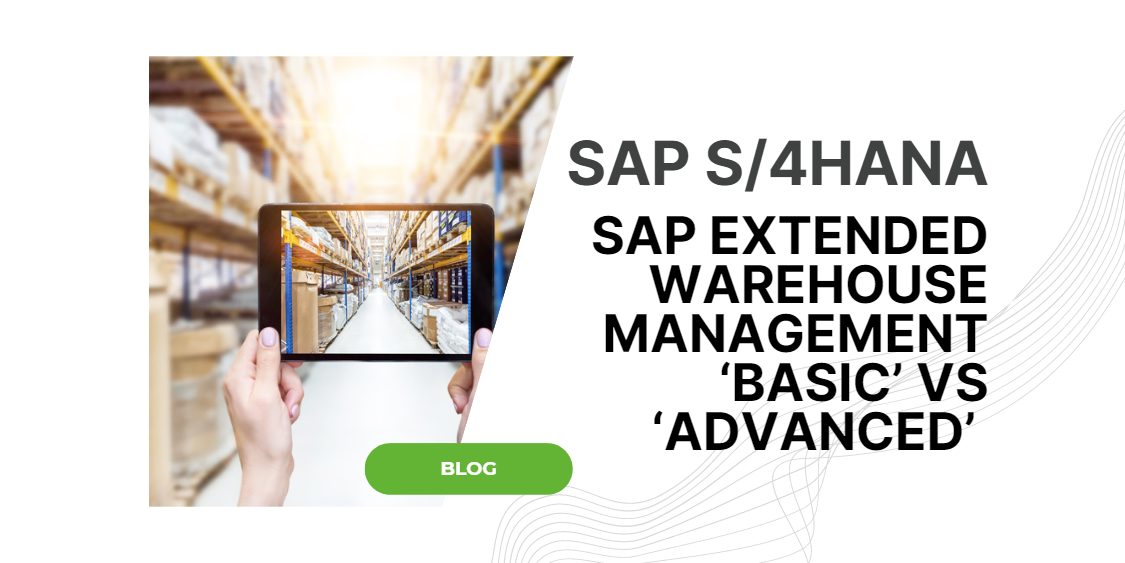SAP Extended Warehouse Management ‘Basic’ vs ‘Advanced’ with S/4HANA

SAP’s Extended Warehouse Management (EWM) solution is steadily becoming one of the market’s leading warehouse management systems.
If you are faced with the need to migrate to new supply chain platforms from either Warehouse Management and/or Transportation in SAP ECC, in this latest blog we explore the varying deployment and migration options provided by Embedded or Side-car (decentralised) SAP EWM in S/4 HANA. We also show how selecting the right approach will help you to gain longevity and sustainable ROI.
SAP EWM offers flexibility and granularity whilst seamlessly integrating with other SAP modules like TM and IBP. This means your supply chain isn’t only in sync, but also offers all of the reporting functionality and opportunities that real time data brings.
SAP’s latest offering is S/4HANA, providing the opportunity to integrate your supply chain needs into one system. EWM-embedded is now not only an option, but can also be used in one of two modes; ‘Basic’ and ‘Advanced’. This provides an ideal opportunity for new or existing customers in the SAP world to upgrade their technology platforms and, with the 2025 deadline looming, EWM is now more accessible and scalable than ever.
Choosing the right version of SAP software and scaling the system appropriately has always been a crucial decision for any business that embarks on an SAP journey. But now, with the use of ‘Basic’ and ‘Advanced’ functions, the customer has the opportunity to reduce licensing costs all round whilst maintaining control and stability.
READ MORE: Why HANA is a Game-Changer for SAP Extended Warehouse Management
Undoubtedly, one of the biggest advantages of choosing embedded SAP EWM is that the ‘Advanced’ licensing costs are applied at the warehouse level. This means that smaller, less complex warehouses that don’t need ‘Advanced’ options such as MFS or VAS, and could still benefit from the same ‘Basic’ functions and the same S/4HANA code base without the inherent cost of unneeded functionality.
It also allows the customer to stagger their migration/implementation approach, making business change easier to manage. All in all, the customer can achieve a minimal viable product with scope to add more complex warehouse processes with the ‘click of a button’, whilst seeing a quicker return on initial investments.
Do you need EWM ‘Advanced’ functions in S/4? Let’s take a look at what they are and what they do.
Material Flow System (MFS)
Manages automation and third party integration via PLC’s to EWM.
Wave Management
Allows the grouping and release of orders to help optimise customer picks and warehouse labour management.
Transportation units / Yard Management
Transportation units and yard management allow for arrival and departure checkpoints in the yard. They also allow for multiple handling units to be processed in one transaction, and maintain visibility of loaded vehicles whilst in the yard.
Labour Management
Allows the warehouse to optimise its labour usage and therefore plan more accurately for labour.
Value Added Services (VAS)
Value added services can come in a variety of shapes and forms. They are additional processing steps either at Goods receipt or at Goods issue. Options include labelling, assembling and packing.
Warehouse Billing
Warehouse billing allows the warehouse to bill customers for services used within a period of time, or can also be used to self bill a third-party whose services our warehouse has been using.
Kitting
Kitting comes in three forms: KIT to order, KIT to stock and reverse Kitting. Kitting is a warehouse process used to store/pick a group of parts/items/products that are part of a bill of materials in the production process. Reverse Kitting is the breakdown of a KIT back to individual items which are then put back into the warehouse stock.
Dock Appointment Scheduling (DAS)
Designed to reduce bottlenecking on the dock and allow for a planned delivery schedule which would help level the delivery cycle. DAS can be used either directly by the customer or as a planning tool by the warehouse.
Slotting
Slotting is designed to optimise the warehouse for products, making sure there put-away and removal indicators are correctly assigned, packaging specifications exist and are valid as well as pick bins.
Cartonisation planning
Cartonisation planning improves the creation of shipping handling units (HUs) based on information from the product master data and outbound delivery orders, such as quantities, volume and weight. Cartonisation planning results in the creation of planned shipping handling units (PSHUs) that you can use as templates for creating shipping HUs during picking or packing.
TM Integration
Direct integration with the Transport management module, which also has the same offering as EWM (a ‘Basic’ and’ Advanced’ version in S/4HANA). The basic version is based on the old LE-TRA with the same licencing options as EWM.
There are standard reports that come with the system to check the usage of ‘Basic’ vs ‘Advanced’. The licensing for EWM follows the original metric and is priced per 5,000 delivery items. If your business runs large scale warehouses then a decentralised ‘side car’ option is the SAP recommended approach, which continues licensing in the usual decentralised way.
Let Rocket help you understand the relevance of SAP S/4HANA for your business
Many of our customers are seeking to make a business case and understand where HANA can bring additional benefits and how it would help them deliver these benefits available.
Focused on driving incremental value for our customers from a move to S4, Rocket is helping customers benefit from the access to the new embedded digital supply chain capabilities from both SAP Transportation Management (SAP TM) and Extended Warehouse Management (SAP EWM).
Are you faced with the need to migrate to new supply chain platforms from either Warehouse Management and/or Transportation in SAP ECC? Speak to us to learn about our accelerated roadmap provision, enabling customers to migrate their supply chain functions in advance of the S4 move to reduce risk of deployment, without complicating the final S4 landscape.
Our experience is benefiting customers when implementing the key technologies to take advantage of HANA. Learn more about our SAP S/4HANA Consulting Solutions to help you derive maximum value from a move to S/4HANA.
Get in Touch. Find out how we can give you the knowledge and insight to make the right decision for your business.



